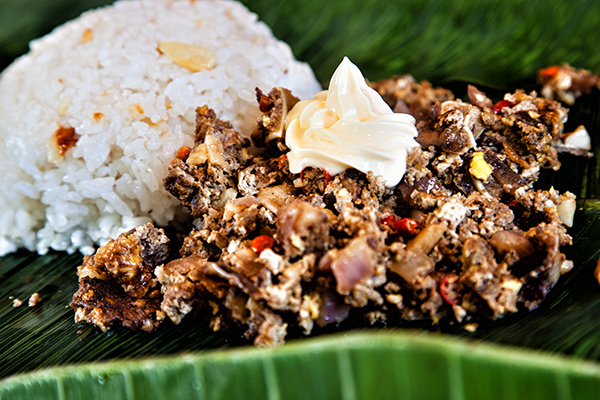Yana Gilbuena may be petite, but she has a large, ebullient personality. Her laughter fills a room, and her voice is expressive and melodic. She thinks big, too. The 32-year-old former Brooklyn-based now gypsy chef started her pop-up dinners as a way to satiate her longing for the food of her native Iloilo. But after seeing success in New York, she decided to grow the concept to 50 states in 50 weeks. Called The Salo Project (derivative of the word “salu-salo”), her moveable pop-up dinners began in Key West in March 2014, finished in Oahu in March 2015 and has since moved on to Canada. She now has plans for Central and South America in 2016.
—Lisa and Irene Yadao
Q: How old were you when you moved to the States?
A: I was 20, going on 21.
Q: Where did you grow up and how did Filipino food fit into your childhood and adulthood?
A: I grew up in Iloilo City, in Panay island in the Philippines. Filipino food was omniscient. It was my constant. I grew up with it, I lived with it. I even brought it with me after I immigrated. Culinary career-wise, I didn’t start until 2013 when I started my Filipino pop-up dinners in Brooklyn.
Q: When or how did you come to realize there was a market or a need for your dishes?
A: I think I realized it on a winter night in Red Hook, Brooklyn, when I was craving Arroz Caldo and I couldn’t order it through Seamless, couldn’t get this hot gingery chicken and rice porridge delivered to my door. [I figured] there here must be a market for this. There was a lack of representation of regional Filipino food and I saw an opportunity to spread our culture through food. I had envisioned a quarterly intimate pop-up dinner, done kamayan style, featuring regional Filipino food using local and seasonal ingredients. And so far, things have worked out far beyond my expectations. I would have never dreamed I would go global, let alone finish the 50 states and Canada.
Q: Could you talk a bit about your trajectory? What were you doing before Salo?
A: My beginnings were in medicine. I was pre-med, taking up a BS in Psychology. I ended up having a minor in Marine Biology because I decided three-quarters of the way that I didn’t want to proceed with med school. I moved to L.A. right after graduation, took a job as a behavior therapist, had a change of heart after three years, and took up a Masters in Architecture. I didn’t finish, but I worked in the interior design industry—as a kitchen and bath designer, furniture designer, antique hardware specialist, furniture store manager, visual merchandiser, social media manager and PR and marketing director. I started doing SALO as a hobby, a side hustle if you will. It started out as a quarterly gathering. Just as I was expanding it to a bi-coastal event, I got laid off from my real job. I took it as a sign from the universe that this was my way out, that I should take that metaphorical leap of faith. So I took it. I had to devise a way to make my pop-up dinners sustainable, so my friend said, “There are 52 weeks in a year and there are 50 states — go figure it out.” After four months of planning, I had a route, a purpose (raising money for ARK: Advancement for Rural Kids, to go towards victims of Typhoon Haiyan in Panay), and a goal of doing 50 Filipino pop-up dinners in 50 states, in 50 weeks.
Q: What has surprised you the most about the diners who have attended your pop-ups?
A: I’m surprised that there are mostly a lot of non-Filipinos who come to my dinners. It’s really refreshing and heart-warming to know that other people are interested in our cuisine and culture.
Q: How is your food received by non-Filipinos and non-Filipino Americans?
A: They absolutely love it. It’s new yet familiar at the same time.
Q: What do you mean by new yet familiar?
The beauty of Filipino cuisine is that our history reflects the influences in our food. When I say it’s new, I mean that a lot of people don’t know what Filipino food is, how to define it, how to see its nuances. It is familiar because these flavors have been borrowed, passed down, “Filipinized” if you will, but still have roots in Spanish, Chinese, Indian, Arabic, and Malay cuisines. As a Filipino, I know our first settlers were the ones to create the foundations of our cuisine: the Negritos/Aetas were the hunter-gatherers who took residence in the mountains, smoked meat, roasted it, rubbed leaves to add flavor. The second ones, the Indones (rumored to be the Indians), were the farmers who took over the plains, cultivated crops and “cooked” their food. The third settlers were the Malays—they were the sea gypsies, the coastal folk, who lived in balangay (and later in barangay). They fished, brought tools, used ingredients of the land. Later on, we traded with Chinese, Arabs, Japanese, and Indians, all of whom influenced our food and language. Then the Spanish came and added to our existing cuisine. We are the original fusion; we are the original melting pot. So when I say, it’s new and familiar, it’s just that we can find similarities in our flavors with other cuisines, but ours is a different format/presentation.
Q: What trends are you noticing with Filipino food, whether it’s a dish that’s gaining popularity or chefs trying new twists on old traditions?
A: There’s a lot of modernization going on with our cuisine. A lot of French techniques applied to our dishes, some deconstructions, new forms to old flavors.
Q: Regarding the trend of modernization—could you talk about what you think that will mean to the state of Filipino cuisine in the context of the United States and globally? Do you see this trend as a good thing? Concerning?
A: I’ve always said that Filipino cuisine was shaped with the ingredients we had and as a people, we are highly adaptable. I wouldn’t be surprised if we start to see pinakbet with kohlrabi, kale, sunchokes, asparagus (which, I’ve done already) because it’s taking the concept of what the original dish is: seasonal vegetables sauteed/stewed in shrimp paste. As a chef, or someone who cooks, understanding the basics of a cuisine will give you the ability to play around with it, without mucking up the flavors that essentially make it Filipino. It’s like playing the piano—you gotta learn the chords, the keys, before you can jazz it up.
I see a lot of Filipinos experimenting with other ingredients, other techniques, other way of cooking. I think the only concerning thing is that it might miss its mark as being “Filipino.” It’s definitely “elevating” our cuisine, but I would rather take the route of celebrating our cuisine, not substituting the main ingredients like fish sauce, cane/coconut vinegar, toyo(soy sauce) and bagoong (shrimp paste), which are pretty much the tenets of Filipino flavors.

SALO’s Sisig Recipe
Ingredients:
1. 2 lbs pigs ears
2. 2 lbs. pork belly (sliced)
3. 1 lb of chicken liver (pureed)
4. 1 cup of red Thai chilies (chopped)
5. 2 medium red onions (diced)
6. 1/2 cup of garlic (diced)
7. 1/2 cup soy sauce
8. 1/4 lemon/lime juice
9. 4 eggs
10. Mayo (Kenko or Kewpie mayo)
Procedure:
- In a large pot, boil pigs ears and pork belly together for 30 mins.
- Pre-heat oven to broil or convection bake at 425.
- After the meat boils, place in sheet pan and put in oven.
- Broil/convection bake for 30-45 mins, until crispy.
*Save the pork fat oil
- After meat crisps, dice into small cubes.
- Sautee garlic in pork fat (from broiling), until golden, then add onions, chilies and chicken liver.
- Add diced meat. Then add soy sauce and lime juice.
- Mix and sautee until liver is cooked.
- Crack eggs on top, then keep sauteeing.
- Stop when eggs are done.
- Serve add a dollop of mayonnaise on top.
+ + +
 This story is a part of Off the Menu: Asian America, a multimedia project between the Center for Asian American Media and KQED, featuring a one-hour PBS primetime special by award-winning filmmaker Grace Lee (American Revolutionary: The Evolution of Grace Lee Boggs), original stories and web content.
This story is a part of Off the Menu: Asian America, a multimedia project between the Center for Asian American Media and KQED, featuring a one-hour PBS primetime special by award-winning filmmaker Grace Lee (American Revolutionary: The Evolution of Grace Lee Boggs), original stories and web content.




